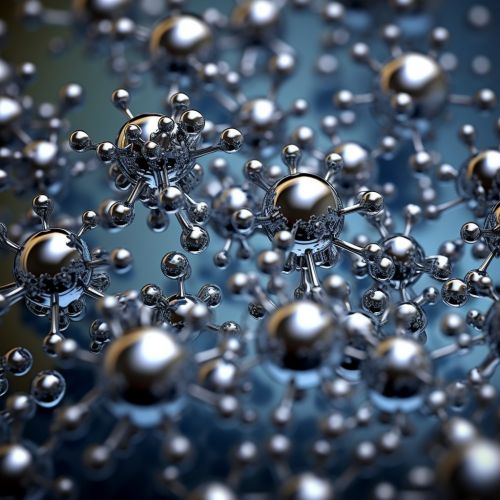Silver Nanoparticle
Introduction
Silver nanoparticles (AgNPs) are particles of silver between 1 nm and 100 nm in size. While frequently described as being 'silver' for color purposes, they come in a range of colors due to their optical properties. Because of their size, they have unique properties that have been extensively researched in modern times.
Synthesis
Silver nanoparticles can be synthesized using a variety of methods, including chemical reduction, physical methods, and biological methods.
Chemical Reduction
Chemical reduction is the most commonly used method for synthesizing silver nanoparticles. This method involves the reduction of silver ions (Ag+) by a reducing agent in the presence of a stabilizing agent. The reducing agent donates electrons to the silver ions, converting them into silver atoms, which then aggregate to form nanoparticles.


Physical Methods
Physical methods of silver nanoparticle synthesis include laser ablation, evaporation-condensation, and mechanical milling. These methods generally do not require the use of hazardous chemicals, making them environmentally friendly. However, they often require specialized equipment and can be energy-intensive.
Biological Methods
Biological methods involve the use of organisms or their byproducts to synthesize silver nanoparticles. These methods are considered green synthesis methods, as they do not involve the use of harmful chemicals. Commonly used organisms include bacteria, fungi, and plants.
Properties
Silver nanoparticles have unique physical, chemical, and biological properties that differ significantly from those of bulk silver.
Physical Properties
The physical properties of silver nanoparticles are largely determined by their size and shape. These properties include optical properties, electrical conductivity, and thermal conductivity.
Chemical Properties
The chemical properties of silver nanoparticles are influenced by their large surface area to volume ratio. This results in a high reactivity and catalytic activity.
Biological Properties
Silver nanoparticles exhibit antimicrobial activity against a wide range of microorganisms, including bacteria, fungi, and viruses. This has led to their use in a variety of applications, including wound dressings, coatings for medical devices, and antimicrobial sprays.
Applications
Due to their unique properties, silver nanoparticles have a wide range of applications in various fields, including medicine, electronics, and environmental science.
Medicine
In medicine, silver nanoparticles are used in a variety of applications due to their antimicrobial properties. They are used in wound dressings to prevent infection, in coatings for medical devices to reduce the risk of device-related infections, and in antimicrobial sprays.
Electronics
In electronics, silver nanoparticles are used in conductive inks for printed electronics, in sensors, and in memory devices.
Environmental Science
In environmental science, silver nanoparticles are used in water treatment for their ability to remove contaminants, in air purification, and in the development of sustainable energy technologies.
Safety and Environmental Impact
The safety and environmental impact of silver nanoparticles is a topic of ongoing research. While they have many beneficial uses, there are concerns about their potential toxicity and environmental impact.
